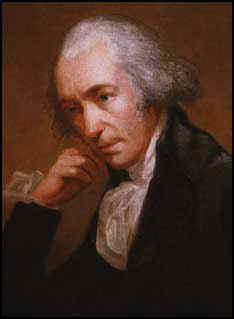James Watt (1736-1819)
 James Watt was born in Greenock in 1736, the son of a ship's chandler
(trader in canvas, etc). Watt had little formal education due to poor health
in his youth, but pottering about in his father's shop he developed an interest
in trying to make things "work like clockwork. In 1757 James Watt became
instrument maker for the University of Glasgow. There he developed his lifelong
interest in steam engines. Watt became acquainted with the Newcomen engine when
he was repairing the University's model of it. After careful consideration
Watt understood that the Newcomen engine model used too much steam (more than
that generated). (portrait
courtesy)
James Watt was born in Greenock in 1736, the son of a ship's chandler
(trader in canvas, etc). Watt had little formal education due to poor health
in his youth, but pottering about in his father's shop he developed an interest
in trying to make things "work like clockwork. In 1757 James Watt became
instrument maker for the University of Glasgow. There he developed his lifelong
interest in steam engines. Watt became acquainted with the Newcomen engine when
he was repairing the University's model of it. After careful consideration
Watt understood that the Newcomen engine model used too much steam (more than
that generated). (portrait
courtesy)
The steam was being used in reheating the cylinder after each injection of cold water. Watt told in his own words, as related to Mr. Robert Hart, many years after:"...the idea came into my mind that, as steam was an elastic body, it would rush into a vacuum, and, if a communication were made between the cylinder and an exhausted vessel, it would rush into it, and might be there condensed without cooling the cylinder." Watt built a first engine model and decided that the steam would to go in the cylinder above the piston.
The cylinder was closed with a cap with a stuffing box for the rod to pass through. The steam helped atmospheric pressure to drive the piston down. In 1769 Watt sought and obtained a patent for a "new method for lessening the consumption of steam and fuel in fire engines". When Watt gained support for developing his engine from the great Birmingham manufacturer, Matthew Boulton, he started manufacturing engines.
In 1776, he built an engine with a cylinder of 127 cm diameter to pump water at Bloomfield Colliery. In the same year Wilkinson, iron master, built a new type of lathe. This lathe made possible to bore a cylinder with a precision which had never before been seen. The final version of the new Watt engine (please see the animation) worked in 1778. In 1782 Watt made his double-acting engine (please see the animation). With this improvement the engine had double the power with the same displacement. To further save coal, the steam was admitted inside the cylinder for a fraction of the stroke which continued by steam expansion. Watt never developed engines that were powerful for their weight, because he refused to use high-pressure steam. He feared that could not make the boiler and engine strong enough to withstand such pressure with the iron and workmanship of the time. He did, however, make minor improvements, such as the steam governor that now is named "Watt's governor".
In 1882, 63 years after Watt's death, the British Association gave his name to the unit of electrical power - and today James Watt's name is to be found written on almost every light bulb in the world.

Connect with us
Contact us today